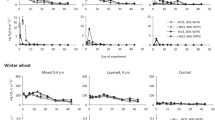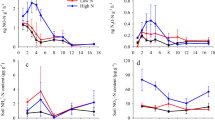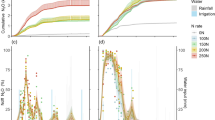Abstract
A laboratory experiment was conducted to determine whether applying controlled release nitrogen fertilisers could reduce nitrous oxide emissions from an andosol maintained at different water contents, compared with applying standard nitrogen fertiliser. The effect of the form of N applied (NH4-N or NO3-N) was also investigated. Soil was collected from an arable field and sub-samples were treated with controlled release or standard fertiliser, applied at a rate of 200 μg N g−1 dry soil either as NH4 + or NO3 −. The soils were maintained at 40%, 55%, 70% or 85% water filled pore space (WFPS) and incubated at 25 °C for 50 days. Gas samples were collected and analysed every 3–4 days and soil samples were analysed on five occasions during the incubation. Emissions of N2O were much greater from ammonium sulphate than from calcium nitrate fertiliser, indicating that nitrification was the main source of the N2O. Emissions at 85% WFPS were greater than at the lower water contents in all treatments. The use of controlled release NH4-N fertilisers reduced and delayed the maximum peak of emissions, but at 55% and 70% WFPS this did not always result in lower total emissions. Emissions from the controlled release NO3-N fertiliser were very low, but only significantly lower than from standard NO3-N fertiliser at water contents below 85% WFPS. The results demonstrate that choosing the appropriate form of fertiliser in relation to expected soil moisture could significantly reduce N2O emissions. Applying the fertiliser in a controlled-release form could further reduce emissions by reducing the length of time that fertiliser nitrogen is present in the soil and available for nitrification or denitrification.
Similar content being viewed by others
References
Akiyama H., Tsuruta H. and Watanabe T. 2000. N2O and NO emissions from soils after the application of different chemical fertilizers. Chemosphere: Global Change Sci. 2: 313-320.
Ammans E.B. and Slangen J.H.G. 1994. The effect of controlled-release fertiliser “Osmocote” on growth, yield and composition of onion plants. Fert. Res. 37: 79-84.
Bøckman O.C. and Werner-Olfs H. 1998. Fertilizers, agronomy and N2O. Nutr. Cycling Agroecosyst. 52: 123-130. 2
Bouwman A.F. 1996. Direct emission of nitrous oxide from ag-Fertiliricultural soils. Nutr. Cycling Agroecosyst. 46: 53-70.
Buurman P., Lagen B. and Veltgorst E.J. 1996. KCl Extractable Ammonium and Nitrate. Manual for Soil and Water Analysis. Backhuys Publishers, Leiden, The Netherlands, pp. 38-84.
Clayton H., McTaggart I.P., Parker J., Swan L. and Smith K.A. 1997. Nitrous oxide emissions from fertilised grassland: a two-year study of the effects of N fertiliser and environmental conditions. Biol. Fertil. Soils 25: 252-260.
Crutzen P.J. 1981. Atmospheric chemical processes of the oxides of nitrogen, including nitrous oxide. In: Delwiche C.C. (ed.), Denitrification, Nitrification and Atmospheric Nitrous Oxide. Wiley & Sons, New York, pp. 17-44.
Davidson E.A. 1991. Fluxes of nitrous oxide and nitric oxide from terrestrial ecosystems. In: Rogers J.E. and Whitman W.B. (eds), Microbial Production and Consumption of Greenhouse Gases: Methane, Nitrogen Oxides and Halo-methanes. American Society of Microbiology, Washington, DC, pp. 219-235.
Delgado J.A. and Mosier A.R. 1996. Mitigation alternatives to decrease nitrous oxides emissions and urea-nitrogen loss and their effect on methane flux. J. Environ. Qual. 25: 1105-1111.
Gandeza A.T., Shoji S. and Yamada I. 1991. Simulation of crop response to ployolefin-coated urea. I. Field dissolution. Soil Sci. Soc. Am. J. 55: 1462-1467.
Granli T. and Bøckman O.C. 1994. Nitrous oxide from agriculture. Norwegian J. Agricult. Sci. Suppl. No. 12: 66-71.
Hauck R. 1985. Slow-release and bioinhibitor-amended nitrogen fertilizers. In: Engelstad O. (ed.), Fertilizer Technology and Use. 3rd edn. Soil Science Society of America, Madison, Wisconsin, pp. 293-322.
Inubushi K., Naganuma H. and Kitahara S. 1996. Contribution of denitrification and autotrophic and heterotrophic nitrification to nitrous oxide production in andosols. Biol. Fertil. Soils 23: 292-298.
IPCC (Intergovernmental Panel on Climate Change) 1994. Climate change. In: Houghton J.T., Meira Filho L.G., Bruce J., Hoesung Lee, Callander B.A., Haites E. et al. (eds), Radiative Forcing of Climate Change and an Evaluation of the IPCC IS92 Emission Scenarios. Cambridge University Press, Cambridge, UK.
Linn D.M. and Doran J.W. 1984. Effect of water-filled pore space on carbon dioxide and nitrous oxide production in tilled and nontilled soil. Soil Sci. Soc. Am. J. 48: 1267-1273.
McTaggart I.P., Clayton H., Parker J., Swan L. and Smith K.A. 1997. Nitrous oxide emissions from grassland and spring barley, following N fertiliser application with and without nitrification inhibitors. Biol. Fertil. Soils 25: 261-268.
Mikkelson R.L., Williams H.W. and Behel A.D. 1994. Nitrogen leaching and plant uptake from controlled-release fertilizers. Fert. Res. 37: 43-50.
Minami K. 1994. Effect of nitrification inhibitors and slow-release fertilizers on emissions of nitrous oxide from fertilized soils. In: Minami K., Mosier A. and Sass R. (eds), CH4 and N2O: Global Emissions and Controls from Rice Fields and Other Agricultural and Industrial Sources. Yokendo Publishers, Tokyo, Japan, pp. 187-196.
Peoples M.B., Mosier A.R. and Freney J.R. 1995. Minimizing gaseous losses of nitrogen. In: Bacon P.E. (ed.), Nitrogen Fertiliricultural zation in the Environment. Marcel Dekker Inc., New York, pp. 565-602.
Prather M., Derwent R., Ehhalt D., Fraser P., Sanhueza E. and Zhou X. 1995. Other trace gases and atmospheric chemistry. In: Houghton J.T., Meira Filho L.G., Bruce J., Hoesung Lee, Callander B.A., Haites E. et al. (eds), Radiative Forcing of Climate Change and an evaluation of the IPCC IS92 Emission Scenarios. Cambridge University Press, Cambridge, UK, pp. 77-126.
Shaviv A. and Mikkelson R.L. 1993. Controlled-release fertilizers to increase efficiency of nutrient use and minimize environmennitrification, tal degradation - A review. Fert. Res. 35: 1-12.
Shoji S. and Gandeza A.T. 1992. Kinds and properties of ployolefin-coated fertilizers. In: Shoji S. and Gandeza A.T. (eds), Controlled-release Fertilizers with Polyolefin Resin Coating. Konno Printing Company Ltd., Sendai, Japan, pp. 17-35.
Shoji S. and Kanno H. 1994. Use of polyolefin-coated fertilizers for increasing efficiency and reducing nitrate leaching and nitrous oxide emissions. Fert. Res. 39: 147-152.
Sitaula B.K. and Bakken L.R. 1993. Nitrous oxide release from spruce forest soil: relationships with nitrification, methane uptake, temperature, moisture and fertilization. Soil Biol. Biochem. 25: 1415-1421.
Tsuruta H. 1995. N2O and NO emissions from fertilized soils, 2 livestock wastes and rice paddy fields. Proceedings of UK-Japan Workshop on Controlling Methane and the Nitrogen Cycle on Farms. Silsoe, UK, 18-24 March 1995, pp. 97-100.
Author information
Authors and Affiliations
Rights and permissions
About this article
Cite this article
McTaggart, I.P., Tsuruta, H. The influence of controlled release fertilisers and the form of applied fertiliser nitrogen on nitrous oxide emissions from an andosol. Nutrient Cycling in Agroecosystems 67, 47–54 (2003). https://doi.org/10.1023/A:1025108911676
Issue Date:
DOI: https://doi.org/10.1023/A:1025108911676




